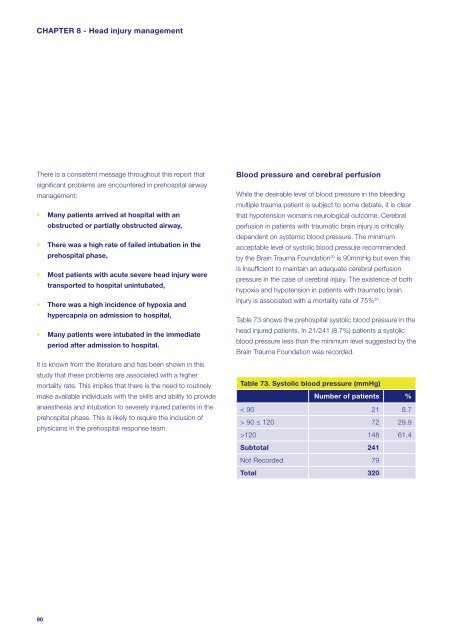NCEPOD: Trauma - Who Cares? - London Health Programmes
NCEPOD: Trauma - Who Cares? - London Health Programmes
NCEPOD: Trauma - Who Cares? - London Health Programmes
Create successful ePaper yourself
Turn your PDF publications into a flip-book with our unique Google optimized e-Paper software.
CHAPTER 8 - Head injury managementThere is a consistent message throughout this report thatsignifi cant problems are encountered in prehospital airwaymanagement:• Many patients arrived at hospital with anobstructed or partially obstructed airway,• There was a high rate of failed intubation in theprehospital phase,• Most patients with acute severe head injury weretransported to hospital unintubated,• There was a high incidence of hypoxia andhypercapnia on admission to hospital,• Many patients were intubated in the immediateperiod after admission to hospital.It is known from the literature and has been shown in thisstudy that these problems are associated with a highermortality rate. This implies that there is the need to routinelymake available individuals with the skills and ability to provideanaesthesia and intubation to severely injured patients in theprehospital phase. This is likely to require the inclusion ofphysicians in the prehospital response team.Blood pressure and cerebral perfusionWhile the desirable level of blood pressure in the bleedingmultiple trauma patient is subject to some debate, it is clearthat hypotension worsens neurological outcome. Cerebralperfusion in patients with traumatic brain injury is criticallydependent on systemic blood pressure. The minimumacceptable level of systolic blood pressure recommendedby the Brain <strong>Trauma</strong> Foundation 20 is 90mmHg but even thisis insuffi cient to maintain an adequate cerebral perfusionpressure in the case of cerebral injury. The existence of bothhypoxia and hypotension in patients with traumatic braininjury is associated with a mortality rate of 75% 20 .Table 73 shows the prehospital systolic blood pressure in thehead injured patients. In 21/241 (8.7%) patients a systolicblood pressure less than the minimum level suggested by theBrain <strong>Trauma</strong> Foundation was recorded.Table 73. Systolic blood pressure (mmHg)Number of patients %< 90 21 8.7> 90 ≤ 120 72 29.9>120 148 61.4Subtotal 241Not Recorded 79Total 32090
















